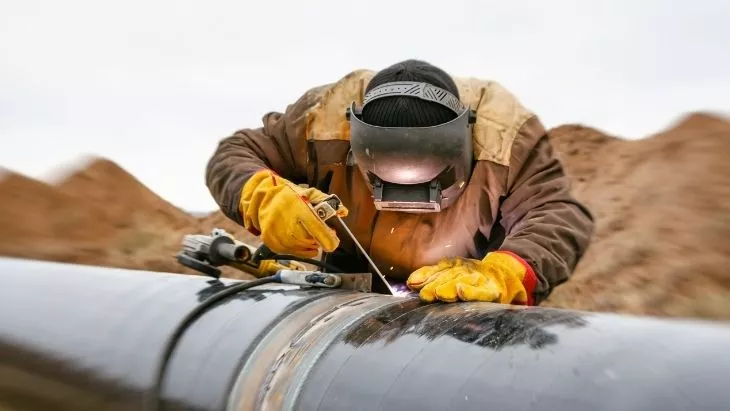Personal safety when welding is not a matter of choice whether you’re an experienced professional welder or just a hobby welder. To some extent, welding safety plays a critical role in the success or failure of your welding career.
One of the questions that many beginners ask themselves is, “can you weld in the rain?” There is no definite answer to this question, but from the electrical engineering point of view, it is not safe at all. It is neither safe nor recommended to weld in the rain due to the high current produced by the welding equipment.
However, at one point or another, you’re bound to encounter wet conditions or be forced to weld in the rain. For instance, if your car breaks down in the middle of a storm, it can be incredibly frustrating to stay in the car for hours waiting for help.
So, can you weld a car part in the rain? Well, it is not illegal to weld in wet conditions, but this does not mean that it is a safe practice. In this blog post, we’ll discuss everything you need to know about welding in the rain and how to keep out of harm’s way.

Is it safe to weld in the rain?
As we have already stated, welding in the rain is very dangerous, and it is highly discouraged reasons being;
Increased risk of electrocution
Considering that welding equipment produces electricity, the chance of electrocution is always there. The risk is further accelerated when electricity combines with water, and since you’ll now be part of the circuit, the results can be fatal. Besides, most welding equipment is not designed to run in water, so leaving your equipment out in the rain can cause permanent damage.
Low weld quality
Although this is not related to safety, welding under wet conditions can cause a myriad of welding defects. Wet electrodes are often associated with weld contamination resulting in weld defects such as porosity, incomplete penetration, cracking, among others.
Drenched clothing
It is a no-brainer that rain is going to soak your protective clothing, and this increases the risk of electrocution even further. Although you can get away by wearing a rain jacket, welding sparks can burn through easily, making the welding current reach your protective clothing.
Can you arc weld in the rain?
Arc welding is one of the most volatile welding processes, and it generates a lot of heat. Furthermore, most arc welders run on AC, which constantly switches between the positive and negative polarity. This interaction can result in a more violent electric shock when the welding arc comes into contact with water or any form of moisture.
As such, it is very dangerous to do arc welding outside in the rain, and we have provided fair reasons for that. In case of a welding emergency or trying to get the job done on time, you can always go for oxyacetylene (gas) welding, which is much safer since it does not involve electricity.
Can you stick weld in the rain?
Stick welding is perhaps the most forgiving when it comes to welding in wet conditions since most stick welders require a DC current. The DC current tends to be more manageable, but it still results in electrical shock. As such, you’ll need to be extremely careful while handling the welder in unpleasant weather conditions.
Can you MIG weld in the rain?
Just like with Arc and Stick welding, it is not prohibited to MIG weld when it is raining or in wet conditions. However, you should try as much as possible to avoid contact with the welding arc to minimize the chances of electrocution. Besides, MIG uses external welding gas, which makes it even harder to weld out in the rain.
Safety precautions for welding in the rain
Welding in the rain comes with its fair share of safety hazards, and unless it is an emergency, we’d suggest you delay the project until the rain subsides. However, if postponing the project is not an option, there are several ways you can keep yourself safe while welding in the rain. Some of the safety measures that you can undertake include;
- Wearing protective footwear, preferably rubber or non-conductive boots, to prevent live current from reaching your feet.
- Always ensure your gloves are in good condition to maintain insulation between the hands and the metals being welded.
- Ensure your hands are well protected when changing welding electrodes
- If possible, use DC current to minimize the risk of electrocution. AC welding is considered more dangerous and can be catastrophic when performed in wet conditions.
- Ensure to cover the welding equipment to minimize chances of getting damaged. Always try and make some sort of shelter for you and the welding machine. For instance, a makeshift tent will come in handy in ensuring rainwater does not reach the machine.
- You may also want to raise the welding equipment off the ground to prevent water puddles from reaching the machine. You can use an MDF board or plywood to help with the same.
- If the equipment gets exposed to water at any point, shut it immediately and find a way to wipe the water before it off before you continue with welding.
The Bottom Line!
Weather is always unpredictable, and sometimes we’re left with no choice but to adapt. Welding in adverse weather conditions seems like an odd idea, but it is generally acceptable. However, you’ll need to take extra measures to protect yourself against electrocution or prevent damaging the welding equipment. It is important to emphasize that water and moisture, in general, have a negative impact on metalworking. So, unless it is really necessary to weld in the rain, it is always a good idea to weld in a dry environment. And it is not just rain; you’ll need to be wary of any kind of moisture, including your own sweat.
